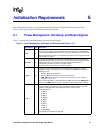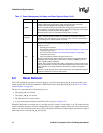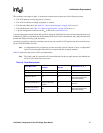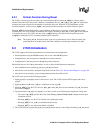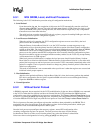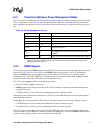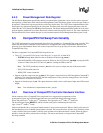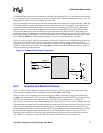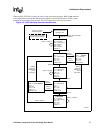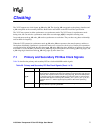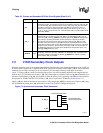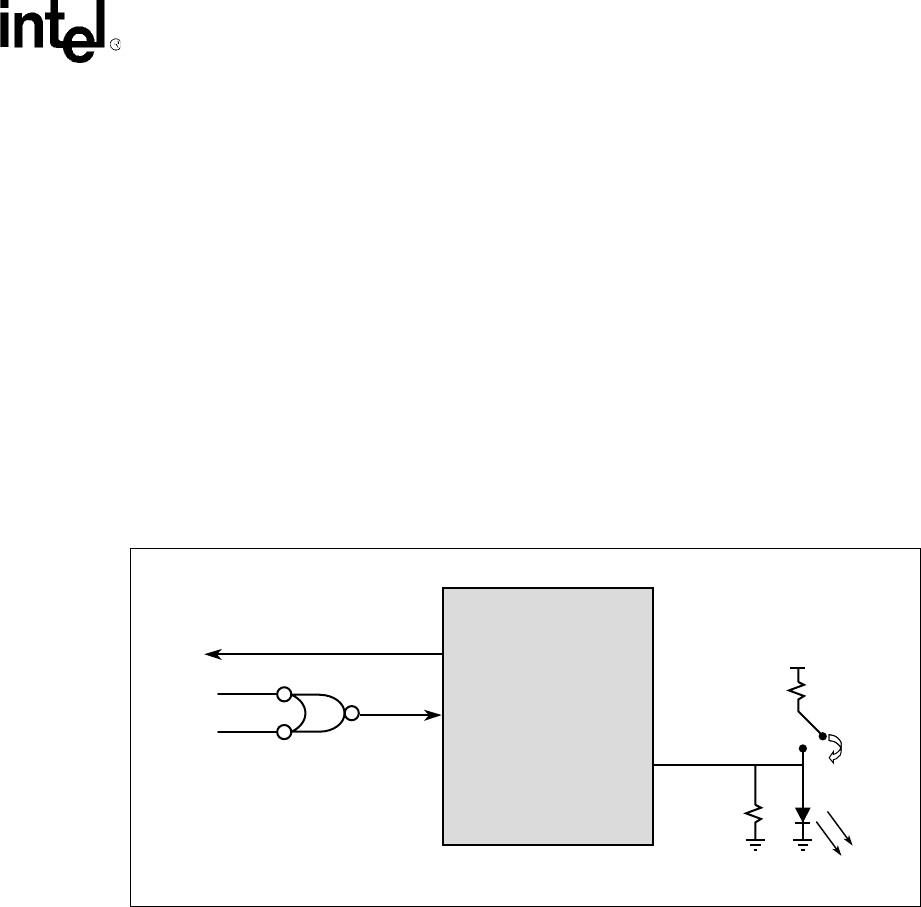
21555 Non-Transparent PCI-to-PCI Bridge User Manual 73
Initialization Requirements
A CompactPCI hot-swap card also implements an indicator LED. When the LED is on, this indicates that the board
can be removed from the slot. Software may choose to flash the LED to indicate an intermediate state as well. The
CompactPCI hot-swap controller controls the state of the LED.
The 21555 multiplexes the microswitch state input and the LED control output onto a single shared pin, l_stat. The
21555 both samples this signal to determine the micro-switch state and drives this signal to control the LED. It is
assumed that onboard debouncing circuitry is used to ensure that a clean edge is provided for the l_stat signal.
Figure 11 on page 73 shows how the l_stat signal can be used on a CompactPCI hot-swap card. Whenever the
21555 drives l_stat, usually when the LOO bit is set, but also in the Signal Removal state, it automatically and
periodically tristates the l_stat signal to sample the state of the micro-switch. Every 1 ms, the 21555 tristates for 8
primary PCI clock cycles to sample its state, when the primary clock is 33 MHz. When the primary clock is faster
than 33 MHz (p_m66ena is asserted), then the number of cycles for tristated and driving is doubled.
The card’s local reset signal, which is asserted upon card removal or insertion, may be OR’ed with the primary bus
reset on the card, and then input to the 21555’s p_rst_l reset input. Alternatively, the secondary reset input
s_rst_in_l can be used as a local reset input. However, if s_rst_in_l is used, p_req64_l is not sampled to determine
whether to enable the 64-bit extension. Instead, pr_ad[1] is sampled and must be pulled up or down to disable or
enable the primary bus 64-bit extension.
.
6.5.2 Insertion and Removal Process
Figure 12 is the 21555 Hot-Swap the insertion and removal process. The flow begins from card insertion. This
occurs when reset: either p_rst_l or s_rst_in_l, is asserted and l_stat is sampled high.
In the Local Reset state, all outputs are tristated, except the secondary reset output, s_rst_l, and (conditionally)
s_req64_l which are driven low. The secondary bus AD[31:0] contents are tristated if CFN is not strapped during
reset. The state of the micro-switch controls the state of the LED in the Local Reset state. As long as the
micro-switch is closed in this state, pulling l_stat high, the LED is on. the 21555 does not drive l_stat in this state.
When both of the reset input signals are detected high (deasserted), the 21555 enters the Serial Preload state. In this
state, the 21555 responds to all transactions with target retry. As long as the micro-switch is closed in this state,
pulling l_stat high, the LED is on. When the micro-switch closes, l_stat is pulled low and the LED turns off. When
the serial preload completes but the lockout bit is still set, the 21555 remains in the Serial Preload state. The
Hot-Swap Control register is still not accessible from the primary side, but can be accessed from the secondary
side. Therefore, it is possible to control the LOO bit, and force the LED on, from the secondary side.
Figure 11. CompactPCI Hot
-Swap Connections
A9079-01
21555
1.3 KΩ
332 Ω
p_enum_l
l_stat
p_rst_l
LRST#
RST#
(Primary)



